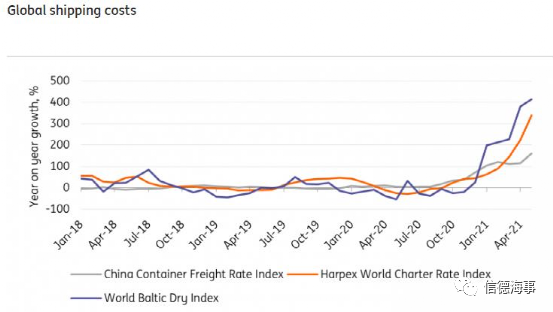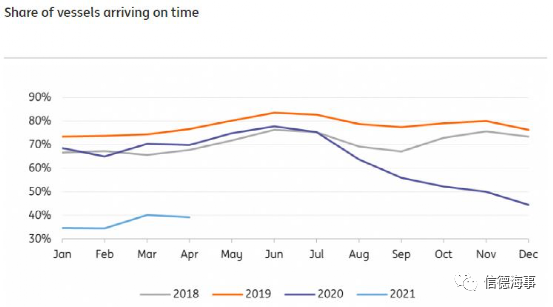Since the autumn of 2020, shipping costs have been increasing strongly, but in the first few months of this year, the freight rates of dry bulk and containers on major trade routes have seen a new surge. Compared with last year, the freight rates of several trade routes have tripled, and the charter prices of container ships have also seen a similar increase.
There is almost no sign of relief in the short term, so freight rates may continue to rise in the second half of this year, because the growth of shipping capacity is limited, the destructiveness of local blockades continues to have an impact on the market, and the growing global demand is still not enough. Satisfy. Even if the new capacity is added, the liner company will manage the fleet more actively, and the freight rate will remain at a higher level than before the epidemic.

Here are five reasons why costs will not drop in the short term.
1.Continued global imbalances have further pushed up prices
The problems that have accumulated since the beginning of the epidemic include: a. Imbalance in the production and demand of goods, b. Blockade and opening of various countries at different times, c. Shipping companies cut the capacity of major routes, and d. There is a shortage of empty containers. With the gradual recovery of the economy, global demand has become stronger, especially in the shipping industry, which is most closely connected with international trade in goods. With the further opening of various economies and the rebuilding of inventory in all links of the supply chain, the requirements for shipping capacity are even higher.

2.Apart from shipping, there are few alternatives
The lack of alternative shipping options means that it is currently difficult to avoid soaring transportation costs. For products with higher value, such as electronic products, other methods such as air or train can usually be selected for transportation, such as by train. Peitai, the current capacity is limited, and freight rates have also risen sharply. For shippers of low-value products such as household goods, toys, promotional items, or T-shirts, the proportion of shipping costs in purchasing costs has risen from about 5% to more than 20%, which also means that consumers may begin to feel the price The impact of rising or product supply changes.
3.The global unbalanced recovery in 2021
The level of merchandise exports in some countries has exceeded that before the outbreak, while in other countries, such as the United States, the level of exports still lags behind the overall output level. Trade in goods will grow further, not only in these major trading countries, but other trading partner countries will also continue to recover.
As the requirements for shipping capacity will continue to exist, the unbalanced global recovery will continue to exacerbate some of the problems of world trade, including “displaced” empty containers, which will put greater pressure on freight rates in the short term.
4.Reducing blank voyages will help ease capacity restrictions
On a global scale, the capacity of major routes has actually returned to the level before the 2020 blockade, although the blank voyages in the first quarter have reduced the planned capacity by 10%. There are signs of improvement this quarter. According to the current fleet plan, the number of blank voyages is 4%. But the cancellation of the voyage is to a certain extent a response to the delay, and it is forced to cancel. O lea la, although the transportation system is still tight, a small amount of capacity may still be reduced in a short period of time to deal with delays.

5.Port congestion and closure continue to cause delays
Just like the link between voyage cancellation and voyage delay, congestion is part of the problem. The shipping performance in 2021 continues the situation in 2020. The proportion of ships sailing as planned has decreased, and the average delay time of overdue ships has increased.
There are signs that the performance of ships will improve, because the proportion of ships arriving on time did not decline in April, and the average delay time of ships has also begun to improve, but the overall performance is still the lowest level in a decade.
I le taim lava lena, the epidemic is still causing damage. Faataitaiga, in early June, the Yantian Port, the fourth largest container port in the world, suddenly closed. Although business has resumed, congestion and epidemic prevention measures mean that delays will increase. Although progress has been made in vaccination in China and other major trading countries, it will take time to establish immunization, so there is a risk of port disruption in the coming months.
The massive increase in container capacity will ease price pressure, but it will have to be after 2023.
During the epidemic, the company has achieved outstanding financial performance. In the first five months of 2021, newbuilding orders for container ships reached a record 229, with a total cargo capacity of 2.2 million TEU. When the new capacity reaches 2023, when the new capacity is ready to be put into use, it will bring about a 6% increase in capacity, but the dismantling of old ships is not expected to offset this increase.
As global economic growth enters the catch-up phase of recovery, the upcoming increase in capacity will put downward pressure on shipping costs, but freight rates may not necessarily return to the pre-epidemic levels, because shipping companies seem to have learned to be better in their alliances To manage capacity.
All in all, in the short term, due to further growth in demand and restrictions such as port congestion, freight rates may reach new highs. Even if capacity restrictions can be eased, freight rates may remain at a higher level than before the epidemic.
VIGA is located in Guangdong Province in China, 13 yeas faucet manaufacturing experience, 60 series products, CUPC, TISI, and ISO 9001 certificated, One hour reach jiagmen port, this is how we keep good quality and competitive prices for global valued customers.
Our main products cover faucets, paipa ta'ele, meafale faletaele, and floor drainer, ma isi.
If any product meets your demand, please feel free to contact us. Catalog & competetive price can be offered.
imeli: info@viga.cc
Website: www.viga.cc
 iVIGA Tap Factory Supplier
iVIGA Tap Factory Supplier
